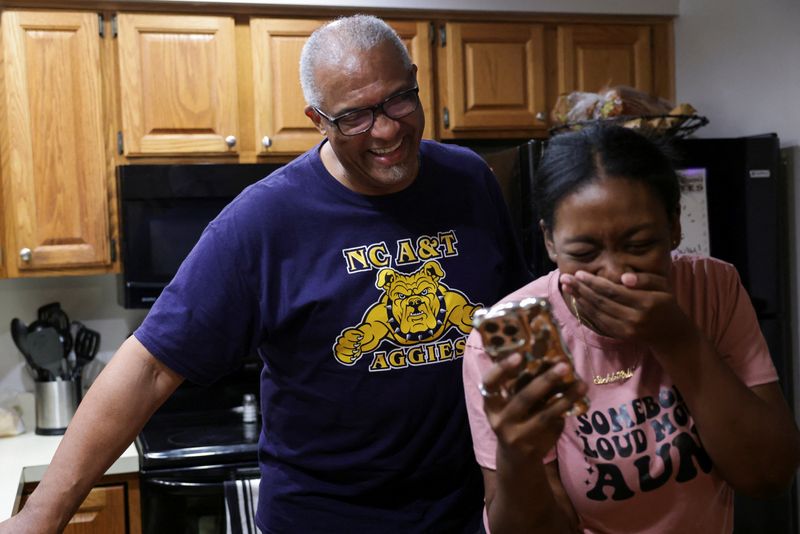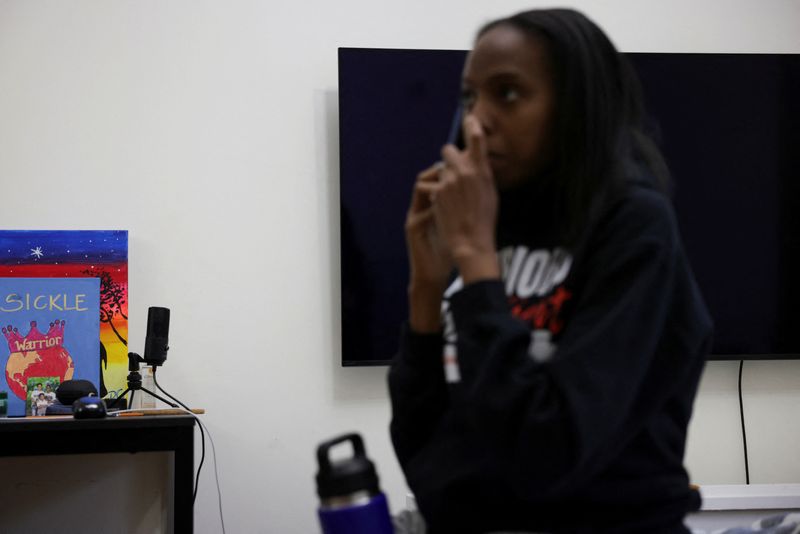By Deena Beasley
LOS ANGELES (Reuters) - Student Zoe Davis, 20, was just weeks into her junior year when she landed back in the hospital with severe sickle cell pain earlier this month. She is doing what she can to prevent the crippling attacks in her arms, legs and abdomen that are becoming more frequent.
She knows new gene therapies may provide long-term relief to some of the 100,000 Americans like her who suffer from sickle cell disease. But she's holding off trying one.
"It is so new ... I wanted to see more success stories before I committed to it," said Davis, who is studying veterinary science at North Carolina Agricultural and Technical State University in Greensboro.
Her hesitation illustrates a common reason why take-up for the potentially life-changing treatments, which cost $2 million to $3 million in the U.S., is proving even slower than expected, interviews with half a dozen U.S. specialists and six sickle cell patients show.
Younger patients – weighing school schedules and reluctant to add more medical burden to their lives – have been less enthusiastic than predicted, said Dr. Leo Wang, hematologist-oncologist at City of Hope Children's Cancer Center near Los Angeles.
"Some kids are just not interested," he said, adding that patients between ages 20 and 40 are, but some have such severe disease that they are not good candidates.
The new one-time treatments, approved in the U.S. last December, have so far been used on around 100 people globally, including in clinical trials. They require chemotherapy, which raises the risk of cancer and can cause infertility.
Some patients say the time involved – up to a year – is a daunting prospect for anyone whose condition is not critical.
Worldwide, 8 million people are estimated to have sickle cell disease, an inherited disorder, according to the National Institutes of Health. Most of those in the U.S. are Black.
Sufferers' red blood cells have an abnormal "sickle" shape that can block their flow through blood vessels, causing excruciating pain and sometimes leading to strokes, organ damage and premature death. The mutation that causes sickle cell is most prevalent in places where malaria is endemic: A single copy of the gene has been shown to protect against malaria infection.
By September, at least 30 people worldwide had begun a one-time gene therapy outside trials, according to the two drugmakers whose therapies were approved in America.
Both treatments involve a months-long process to remove a patient's bone marrow stem cells and genetically modify them in a lab. Patients are given chemotherapy and admitted to hospital to be monitored for weeks after the cells are reinfused.
Doctors say use of the therapies could increase as more data emerges on safety and efficacy, but many patients are waiting on the sidelines - timing pregnancies, weighing the cost of fertility treatments or put off by the lengthy process. Others are seeking insurance approval: Hospitals need to confirm payments in advance.
Also, some younger patients' disease is still under control with standard medicines. Older ones are liable to complications, hematologists said. Those with significant organ damage, a history of stroke or infections such as HIV or hepatitis may not be eligible.
"You have to be sick, but not too sick," said Dr. Andrew Campbell, director of the Children's National Comprehensive Sickle Cell Disease Program in Washington D.C.
'NOT LIKE HOTCAKES'
The companies, doctors and analysts say that more than 80% of U.S. patients are not suitable for the therapies, which are approved only for those over 12 with a history of severe pain crises. Doctors and insurers have stricter criteria.
One of the drugmakers, Bluebird Bio (NASDAQ:BLUE), in August cut its forecast for use of all three of its gene therapy products this year to 85 at most, down from 105. Earlier this week, it said 10 patients had so far started its sickle cell regimen.
The other firm, Vertex Pharmaceuticals (NASDAQ:VRTX), said in August that 20 patients worldwide had begun its treatment process, but still called its therapy "a potential multi-billion dollar opportunity" for about 58,000 patients in the U.S., Europe, Saudi Arabia and Bahrain.
Bluebird's shares are down about 64% this year at around 50 cents. Vertex has risen about 14% to around $463, on par with with gains in the S&P 500 Healthcare index.
Wall Street analysts, on average, expect sales of Vertex's Casgevy to reach $500 million by 2026, according to LSEG data. No consensus forecast is available in the data for Bluebird's treatment, Lyfgenia. This week the company said it would cut 25% of its workforce, mostly from research, to put more resources into selling its existing products.
Thomas Klima, Bluebird's chief operating officer, told Reuters sickle cell patients are "excited" about Lyfgenia, but the payer approval process and steps to clinical readiness take longer than for a typical drug treatment.
Vertex COO Stuart Arbuckle said in an email that the company has been pleased with the response from payers, physicians and patients, but "this was always going to be a foundational year" for Casgevy.
Of other gene therapies approved in recent years, only one has reached blockbuster sales of over $1 billion a year: Novartis (SIX:NOVN)' Zolgensma for spinal muscular atrophy in babies. Uptake of the rest, including one-time hemophilia therapies, has been slow.
The sickle cell therapies are "pretty awesome from a scientific standpoint," said Chris Bardon, co-managing partner of biotech investment firm MPM BioImpact, which has a portfolio that includes gene therapy companies.
But she said they are not expected "to sell like hotcakes," with early use seen mainly in patients with severe disease.
WEEKS OF PAIN
Debilitating sickle cell pains can strike any part of the body, but they most commonly occur in the hands, feet, chest, and back. They can last for a few hours to several weeks.
Existing treatments include blood transfusions, antibiotics for infections, opiates for severe pain and the generic drug hydroxyurea, an anti-cancer pill that helps red blood cells return to normal shape. Pfizer (NYSE:PFE) said this week it was withdrawing its sickle cell disease treatment, Oxbryta, citing risks of a painful complication and deaths.
Until now, the only potential cure for sickle cell disease was a bone marrow transplant, but it is hard to find matched donors for that procedure, which also requires chemotherapy. There is a risk of transplant rejection.
People living with the disease are advised to avoid sudden temperature changes, alcohol or smoking, high altitudes or strenuous exertion, and to steer clear of infection risks. Also, stress can bring on an acute attack that lands them in the emergency room.
Student Davis said moving to college from her home in Virginia heightened the disease progression that many experience as they age. She takes hydroxyurea and folic acid daily, but still her pain crises frequently need hospital treatment.
Kayla Smith Owens, a 25-year-old sickle cell advocate who describes her pain as "constant," was accepted in 2020 into a bone marrow transplant trial, but her donor fell through at the last minute.
She is interested in receiving gene therapy, which her doctors have recommended given that she is young with little to no organ damage. But her insurance coverage is uncertain.
"I turn 26 in November and will be dropped off of my mom's insurance," Smith Owens said. To avoid being cut off at that time, she and her medical team hope the insurer will grant an extension.
Health insurers that have outlined terms are adhering closely to them, said Jennifer Cameron, executive director for patient access at Children's National Hospital, whose job entails communicating with insurers.
"If they say there are 10 points that the patient must meet, they are holding us to those 10 points," she said, noting that insurers have turned down gene therapy coverage for some sickle cell patients whom doctors had recommended.
Vertex partnered with CRISPR Therapeuticsto develop its $2.2 million therapy Casgevy, the first U.S.-approved treatment using gene editing technology to trim faulty parts of a gene and allow patients to produce normal red blood cells.
Bluebird's Lyfgenia uses a viral envelope to deliver a healthy hemoglobin-producing gene. The company sells the $3.1 million therapy only in the U.S.
After infusion with Casgevy, trial data showed that 36 out of 39 patients did not have a severe pain crisis for at least 12 consecutive months. Bluebird's study showed that 32 out of 34 patients had not experienced a severe pain crisis after around three years.
FERTILITY BARRIER
Doctors say they are cautiously weighing the risks of the two gene therapies against the potential benefits.
If patients are doing well on current treatment, Dr. Michael DeBaun, director at Nashville's Vanderbilt-Meharry Center of Excellence in Sickle Cell Disease, questioned the logic of recommending a new gene therapy used so far on so few people.
"You wouldn't do that for cancer," he said. "You would only offer that to people who had the most severe disease who were likely going to die."
Dr. Mark Walters at UCSF Benioff Children's Hospital in Oakland, California expects the therapies to initially be used for about 10% of sickle cell patients, noting the field is moving quickly as researchers aim for therapies that may not require chemo.
"The chemotherapy drug we use causes infertility in most," Walters said.
A cycle of egg freezing can cost up to $15,000, and storage up to $500 a year, according to the non-profit Alliance for Fertility Preservation. Sperm banking can cost up to $1,000 with another $400 a year for storage, the group estimates.
Sickle cell patient Dominique Goodson, 38 and pregnant with her first child, said she would like to get a gene therapy a year or so after she gives birth in December, but she needs to make sure she can preserve fertility options for a second child.
Both Vertex and Bluebird have programs to help with payment for fertility services, but these are not available to patients in the federal government's Medicaid plan for low-income individuals, which covers more than half of U.S. sickle cell patients.
Medicaid has proposed a pilot program starting next year that would include some fertility services, but Vertex is challenging the government's policy in court.

Goodson works with the non-profit Sickle Cell Consortium, focusing on the needs of the sickle cell community, and has participated in focus groups conducted by Vertex and Bluebird.
"I want to be able to live a normalish life ... just being able to enjoy the simple things," she said.
